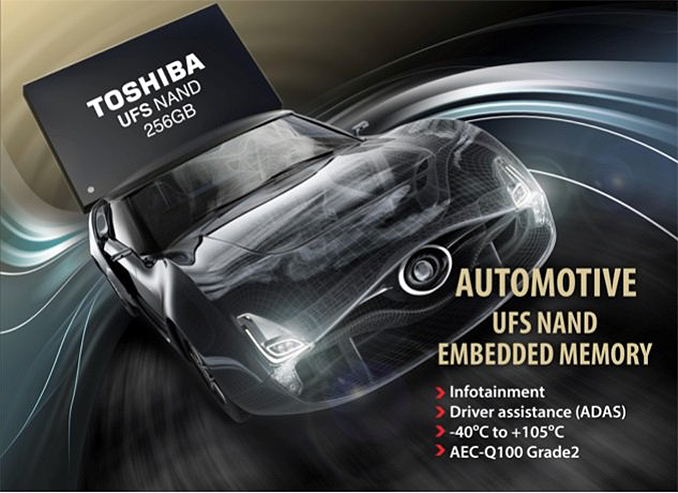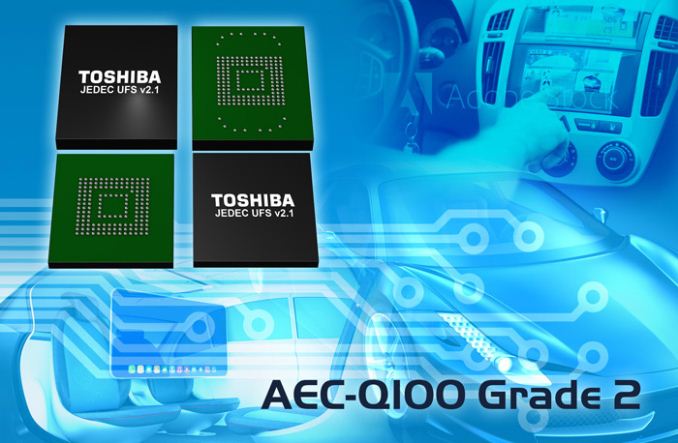Toshiba Samples eUFS Devices for Vehicles: Extended Temps & Reliability Features
by Anton Shilov on December 18, 2017 12:00 PM EST
Toshiba this month announced that it had started sample shipments of the industry’s first automotive grade embedded UFS storage devices for ADAS and infotainment systems. The new eUFS chips offer capacities from 16 GB to 128 GB (with a 256 GB option coming in Q2 2018), can handle extreme temperatures and support numerous features designed to improve their reliability and ensure consistent performance.
The Toshiba eUFS storage devices for automotive applications are based on the company’s proven 128 Gb MLC NAND flash made using 15 nm process technology as well as an in-house developed controller. The devices are compliant with the UFS 2.1 HS-G3 specification, so they use two full-duplex HS-Gear3 lanes with 5.8 GT/s data transfer rate per lane and can offer a theoretical maximum bandwidth of 1200 MB/s. Toshiba does not share actual performance numbers of its eUFS devices (other than saying that sequential read performance of its 64 GB eUFS device is 170% higher than that of its 64 GB eMMC device) and given that it also does not disclose details about its controller, one can only wonder which of the solid-state storage solutions can actually hit the peak interconnection speed.
Toshiba’s eUFS devices are AEC-Q100 Grade 2 qualified, and can operate in extreme temperatures between -40ºC and 105ºC for prolonged amounts of time. Furthermore, they pack a number of features to improve general reliability and endurance, courtesy to the new controller and some other enhancements. In addition to performing regular NAND management (bad block management, error correction, wear leveling, garbage collection, etc), Toshiba’s eUFS controller monitors such things as P/E cycles endured by the cell, temperature and some other (which Toshiba does not disclose) and reports them to the host processor that may take some actions if needed . For example, if the built-in sensor detects that the temperature of the device exceeds 105ºC, it reports it to the controller, which starts to throttle the device to reduce the temperature and passes the notification to the host SoC for further actions. The controller also automatically performs the “refresh” function to extend data retention by moving data from cell to cell to keep charges at decent levels.
| Toshiba Embedded UFS Storage Devices for Automotive Applications | ||||||||
| 16 GB | 32 GB | 64 GB | 128 GB | 256 GB | ||||
| NAND Type | 128 Gb MLC NAND, 15 nm | |||||||
| Controller | Developed in-house | |||||||
| Interface | UFS 2.1 two full-duplex HS-Gear3 lanes with 5.8 GT/s per lane up to 1200 MB/s |
|||||||
| Operating Temperatures | -40ºC to 105ºC -40ºF to 221ºF |
|||||||
| Qualification | AEC-Q100 Grade 2 | |||||||
| Health Status Monitor | Yes | |||||||
| Data Retention | Yes, through "Refresh" feature | |||||||
| Thermal Sensor | Yes | |||||||
| Voltage | Memory | 2.7 V - 3.6 V | ||||||
| Interface | 1.7 V - 1.95 V | |||||||
| Package | Type | FBGA-153 | FBGA-169 | |||||
| Width | 11.5 mm | 12 mm | ||||||
| Length | 13 mm | 16 mm | ||||||
| Height | 1 mm | 1.2 mm | 1.6 mm | |||||
| Sample Availability | December 2017 | Q2 2018 | ||||||
Samples of Toshiba’s eUFS automotive-grade storage devices are available to interested parties. Meanwhile, Toshiba intends to add a 256 GB eUFS solution (based on the same memory and controller) to the lineup sometimes in Q2. Since vehicles take a long time to develop, it will be a while before Toshiba starts commercial shipments of the products.
Related Reading:
- Toshiba Samples New UFS 2.1 NAND: Up to 900 MB/s Reads For 2018 Smartphones
- SanDisk Launches SD and microSD for Industrial and Automotive: Extreme Temps, Upped Reliability
- Samsung Announces 256GB UFS Embedded Storage Solution
- Samsung Announces 128GB UFS Storage For Smartphones
- Toshiba and Qualcomm Set to Introduce UFS 2.0 Solutions in 2014
Source: Toshiba











14 Comments
View All Comments
boeush - Monday, December 18, 2017 - link
Just wondering - if it can function at -40C, then what could stop it from functioning at -100C, or at absolute zero for that matter? It's not as if it relies on liquids or gases for operation - it's solid state by definition... Anyone know?quiksilvr - Monday, December 18, 2017 - link
Colder temperatures start effecting things at a molecular level. So going colder you start effecting how electrons are going through the circuit. This is what generally causes data corruption. As for absolute zero, magnetism basically disappears. So there is a limit, even for sold state devices.extide - Monday, December 18, 2017 - link
Magnetism disappears at near zero? Don't superconducting magnets work down near zero?FunBunny2 - Monday, December 18, 2017 - link
"Don't superconducting magnets work down near zero?"no, not really. their electromagnets, and *coils* in the pole pieces are vewy, vewy cold, but not magnetic material. you can get that from the Wiki. here's a piece on what happens to monolithic magnetic material when it gets vewy, vewy cold: http://physicsworld.com/cws/article/news/2007/feb/...
Santoval - Tuesday, December 19, 2017 - link
I believe that article refers to the application of strong magnetic fields (above the "critical magnetic field" of superconductors), not to their critical temperature (Tc), which is what the question was really about (with superconductors allowing the *construction* of "superconducting magnets", rather than being inherently magnetic - since they are diamagnetic).Would a superconductor retain zero resistance at a highly speculative (but impossible, since 0K means zero entropy, which is not allowed - and this doubly speculative and impossible, since we are talking about removing all thermal energy while retaining the electric current) absolute zero or would its Cooper pairs of electrons freeze in place? I honestly have no idea, but I am quite sure it would work at nanoKelvin and even picoKelvin and lower.
willis936 - Monday, December 18, 2017 - link
Industrial used to be rated for -55C but switched to -40C when people realized the extra 15 degrees of verification didn't justify cooling methods more exotic than plain old LN2. Unless you're sending stuff into space does it really matter? If you are then verification is probably more than half of the cost of the components.Zingam - Monday, December 18, 2017 - link
They did it to fuck up Russian and Canadian business!DanNeely - Monday, December 18, 2017 - link
In addition to electrical effects,At colder temperatures many materials become more brittle which affects the mechanical strength of the object. (I recently read an article about one of the telescopes operated at the south pole; one of the challenges they listed for the extreme conditions was that plastic wire insulation only rated for -40 would become as brittle and rigid as glass at -110C)
Differential thermal contraction is becomes more extreme as temperatures drop lower; to avoid the product bend/breaking itself materials with more similar contraction rates and/or more strain relief are needed at -100C than at -40.
extide - Monday, December 18, 2017 - link
It will likely work fine at much lower than -40, it's just only qualified/guaranteed to run down to that level.Zingam - Monday, December 18, 2017 - link
How about mechanical stress on the materials?If you freeze it to -100 deg it might never work again.